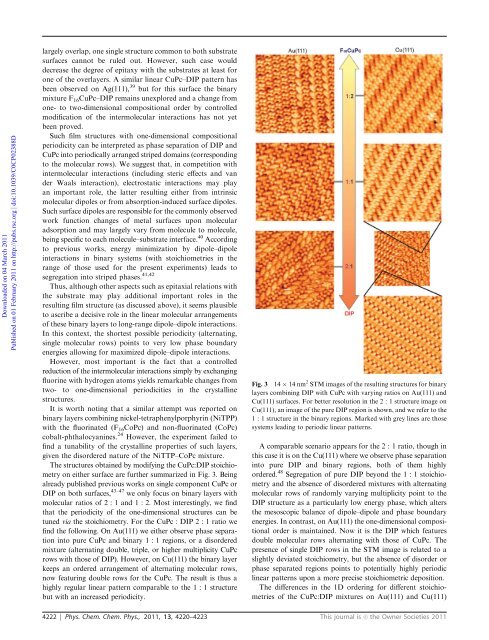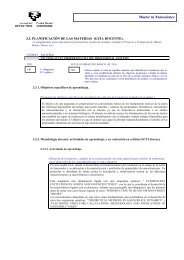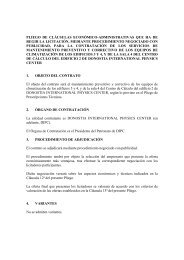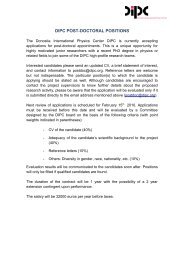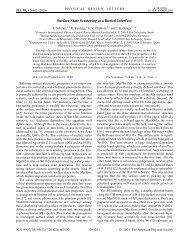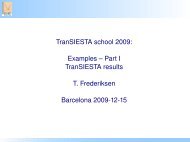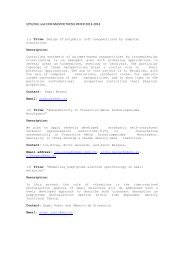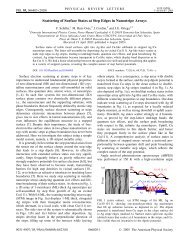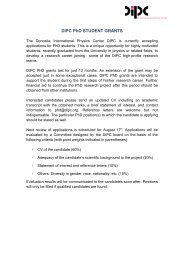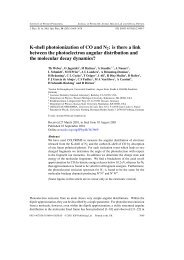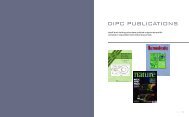Downloaded on 04 March 2011 Published on 01 February 2011 on http://pubs.rsc.org | doi:10.1039/C0CP02388D largely overlap, one s<strong>in</strong>gle structure common to both substrate surfaces cannot be ruled out. However, such case would decrease the degree of epitaxy with the substrates at least for one of the overlayers. A similar l<strong>in</strong>ear CuPc–DIP pattern has been observed on Ag(111), 39 but for this surface the b<strong>in</strong>ary mixture F 16 CuPc–DIP rema<strong>in</strong>s unexplored <strong>and</strong> a change from one- to two-dimensional compositional order by controlled modification of the <strong>in</strong>termolecular <strong>in</strong>teractions has not yet been proved. Such film structures with one-dimensional compositional <strong>periodicity</strong> can be <strong>in</strong>terpreted as phase separation of DIP <strong>and</strong> CuPc <strong>in</strong>to periodically arranged striped doma<strong>in</strong>s (correspond<strong>in</strong>g to the molecular rows). We suggest that, <strong>in</strong> competition with <strong>in</strong>termolecular <strong>in</strong>teractions (<strong>in</strong>clud<strong>in</strong>g steric effects <strong>and</strong> van der Waals <strong>in</strong>teraction), electrostatic <strong>in</strong>teractions may play an important role, the latter result<strong>in</strong>g either from <strong>in</strong>tr<strong>in</strong>sic molecular dipoles or from absorption-<strong>in</strong>duced surface dipoles. Such surface dipoles are responsible for the commonly observed work function changes of metal surfaces upon molecular adsorption <strong>and</strong> may largely vary from molecule to molecule, be<strong>in</strong>g specific to each molecule–substrate <strong>in</strong>terface. 40 Accord<strong>in</strong>g to previous works, energy m<strong>in</strong>imization by dipole–dipole <strong>in</strong>teractions <strong>in</strong> b<strong>in</strong>ary systems (with stoichiometries <strong>in</strong> the range of those used for the present experiments) leads to segregation <strong>in</strong>to striped phases. 41,42 Thus, although other aspects such as epitaxial relations with the substrate may play additional important roles <strong>in</strong> the result<strong>in</strong>g film structure (as discussed above), it seems plausible to ascribe a decisive role <strong>in</strong> the l<strong>in</strong>ear molecular arrangements of these b<strong>in</strong>ary layers to long-range dipole–dipole <strong>in</strong>teractions. In this context, the shortest possible <strong>periodicity</strong> (alternat<strong>in</strong>g, s<strong>in</strong>gle molecular rows) po<strong>in</strong>ts to very low phase boundary energies allow<strong>in</strong>g for maximized dipole–dipole <strong>in</strong>teractions. However, most important is the fact that a controlled reduction of the <strong>in</strong>termolecular <strong>in</strong>teractions simply by exchang<strong>in</strong>g fluor<strong>in</strong>e with hydrogen atoms yields remarkable changes from two- to one-dimensional periodicities <strong>in</strong> the crystall<strong>in</strong>e structures. It is worth not<strong>in</strong>g that a similar attempt was reported on b<strong>in</strong>ary layers comb<strong>in</strong><strong>in</strong>g nickel-tetraphenylporphyr<strong>in</strong> (NiTPP) with the fluor<strong>in</strong>ated (F 16 CoPc) <strong>and</strong> non-fluor<strong>in</strong>ated (CoPc) cobalt-phthalocyan<strong>in</strong>es. 24 However, the experiment failed to f<strong>in</strong>d a tunability of the crystall<strong>in</strong>e properties of such layers, given the disordered nature of the NiTTP–CoPc mixture. The structures obta<strong>in</strong>ed by modify<strong>in</strong>g the CuPc:DIP stoichiometry on either surface are further summarized <strong>in</strong> Fig. 3. Be<strong>in</strong>g already published previous works on s<strong>in</strong>gle component CuPc or DIP on both surfaces, 43–47 we only focus on b<strong>in</strong>ary layers with molecular ratios of 2 : 1 <strong>and</strong> 1 : 2. Most <strong>in</strong>terest<strong>in</strong>gly, we f<strong>in</strong>d that the <strong>periodicity</strong> of the one-dimensional structures can be tuned via the stoichiometry. For the CuPc : DIP 2 : 1 ratio we f<strong>in</strong>d the follow<strong>in</strong>g. On Au(111) we either observe phase separation <strong>in</strong>to pure CuPc <strong>and</strong> b<strong>in</strong>ary 1 : 1 regions, or a disordered mixture (alternat<strong>in</strong>g double, triple, or higher multiplicity CuPc rows with those of DIP). However, on Cu(111) the b<strong>in</strong>ary layer keeps an ordered arrangement of alternat<strong>in</strong>g molecular rows, now featur<strong>in</strong>g double rows for the CuPc. The result is thus a highly regular l<strong>in</strong>ear pattern comparable to the 1 : 1 structure but with an <strong>in</strong>creased <strong>periodicity</strong>. Fig. 3 14 14 nm 2 STM images of the result<strong>in</strong>g structures for b<strong>in</strong>ary layers comb<strong>in</strong><strong>in</strong>g DIP with CuPc with vary<strong>in</strong>g ratios on Au(111) <strong>and</strong> Cu(111) surfaces. For better resolution <strong>in</strong> the 2 : 1 structure image on Cu(111), an image of the pure DIP region is shown, <strong>and</strong> we refer to the 1 : 1 structure <strong>in</strong> the b<strong>in</strong>ary regions. Marked with grey l<strong>in</strong>es are those systems lead<strong>in</strong>g to periodic l<strong>in</strong>ear patterns. A comparable scenario appears for the 2 : 1 ratio, though <strong>in</strong> this case it is on the Cu(111) where we observe phase separation <strong>in</strong>to pure DIP <strong>and</strong> b<strong>in</strong>ary regions, both of them highly ordered. 48 Segregation of pure DIP beyond the 1 : 1 stoichiometry <strong>and</strong> the absence of disordered mixtures with alternat<strong>in</strong>g molecular rows of r<strong>and</strong>omly vary<strong>in</strong>g multiplicity po<strong>in</strong>t to the DIP structure as a particularly low energy phase, which alters the mesoscopic balance of dipole–dipole <strong>and</strong> phase boundary energies. In contrast, on Au(111) the one-dimensional compositional order is ma<strong>in</strong>ta<strong>in</strong>ed. Now it is the DIP which features double molecular rows alternat<strong>in</strong>g with those of CuPc. The presence of s<strong>in</strong>gle DIP rows <strong>in</strong> the STM image is related to a slightly deviated stoichiometry, but the absence of disorder or phase separated regions po<strong>in</strong>ts to potentially highly periodic l<strong>in</strong>ear patterns upon a more precise stoichiometric deposition. The differences <strong>in</strong> the 1D order<strong>in</strong>g for different stoichiometries of the CuPc:DIP mixtures on Au(111) <strong>and</strong> Cu(111) 4222 Phys. Chem. Chem. Phys., 2011, 13, 4220–4223 This journal is c the Owner Societies 2011
Downloaded on 04 March 2011 Published on 01 February 2011 on http://pubs.rsc.org | doi:10.1039/C0CP02388D reveal the pronounced <strong>in</strong>terplay between the <strong>in</strong>termolecular <strong>in</strong>teractions (<strong>in</strong>clud<strong>in</strong>g short-ranged steric effects, medium ranged van-der-Waals <strong>and</strong> longer ranged electrostatic <strong>in</strong>teractions) <strong>and</strong> those between the molecule <strong>and</strong> substrate. However, most importantly we have found that the l<strong>in</strong>ear nature of the molecular arrays can be obta<strong>in</strong>ed for different stoichiometries <strong>and</strong> their lateral <strong>periodicity</strong> can thus be varied <strong>in</strong> a controlled way. In conclusion, we have shown how control of the <strong>in</strong>termolecular <strong>in</strong>teractions <strong>in</strong> b<strong>in</strong>ary <strong>supramolecular</strong> layers of homeomorphic components can change the <strong>symmetry</strong> of their highly crystall<strong>in</strong>e nanostructures. An exchange of fluor<strong>in</strong>e <strong>and</strong> hydrogen atoms with<strong>in</strong> a molecule can <strong>in</strong>hibit the formation of hydrogen bonds <strong>and</strong> change the structure of the b<strong>in</strong>ary layers from hav<strong>in</strong>g a two- to a one-dimensional compositional <strong>periodicity</strong>. In addition, by chang<strong>in</strong>g the stoichiometry of the deposition we can tune the <strong>periodicity</strong> of the b<strong>in</strong>ary structures. This has been proved for molecular ratios between 2 : 1 <strong>and</strong> 1 : 2, but controllability of the <strong>periodicity</strong> over a larger range might be equally possible go<strong>in</strong>g to more disparate stoichiometries. Altogether, this communication reports on <strong>supramolecular</strong> self-assembly <strong>in</strong> which we obta<strong>in</strong> molecular templates with tunable <strong>symmetry</strong> <strong>and</strong> <strong>periodicity</strong>, a l<strong>and</strong>mark <strong>in</strong> organic self-assembly of potential use for subsequent synthesis of tailored functional molecular nanostructures. Acknowledgements D.G.O. acknowledges the Japanese Society for the Promotion of Science (JSPS) for a short-term postdoctoral fellowship. Notes <strong>and</strong> references 1 H. L. Zhang, W. Chen, L. Chen, H. Huang, X. S. Wang, J. Yuhara <strong>and</strong> A. T. S. Wee, Small, 2007, 3, 2015. 2 S. Berner, M. Corso, R. Widmer, O. Groen<strong>in</strong>g, R. Laskowski, P. Blaha, K. Schwarz, A. Goriachko, H. Over, S. Gsell, M. Schreck, H. Sachdev, T. Greber <strong>and</strong> J. Osterwalder, Angew. Chem., Int. Ed., 2007, 46, 5115. 3 N. Neel, J. Kro¨ ger <strong>and</strong> R. Berndt, Adv. Mater., 2006, 18, 174. 4 R. Otero, Y. Naitoh, F. Rosei, P. Jiang, P. Thostrup, A. Gourdon, E. Lægsgaard, I. Stensgaard, C. Joachim <strong>and</strong> F. Besenbacher, Angew. Chem., Int. Ed., 2004, 43, 2092. 5 F. Silly, A. Q. Shaw, K. Porfyrakis, G. A. D. Briggs <strong>and</strong> M. R. Castell, Appl. Phys. Lett., 2007, 91, 253109. 6 J. A. Theobald, N. S. Oxtoby, M. A. Phillips, N. R. Champness <strong>and</strong> P. H. Beton, Nature, 2003, 424, 1029. 7M.E.Can˜ as-Ventura,W.Xiao,D.Wasserfallen,K.Mu¨ llen,H.Brune, J. V. Barth <strong>and</strong> R. Fasel, Angew. Chem., Int. Ed., 2007, 46, 1814. 8 M. Ruiz-Oses, N. Gonzalez-Lakunza, I. Silanes, A. Gourdon, A. Arnau <strong>and</strong> J. E. Ortega, J. Phys. Chem. B, 2006, 110, 25573. 9 M. Treier, M.-T. Nguyen, N. V. Richardson, C. Pignedoli, D. Passerone <strong>and</strong> R. Fasel, Nano Lett., 2009, 9, 126. 10 S. De Feyter <strong>and</strong> F. C. De Schryver, Chem. Soc. Rev.,2003,32,139. 11 L. Grill, M. Dyer, L. Lafferentz, M. Persson, M. V. Peter <strong>and</strong> S. Hecht, Nat. Nanotechnol., 2007, 2, 687. 12 R. Gutzler, H. Walch, G. Eder, S. Kloft, W. M. Hecklab <strong>and</strong> M. Lack<strong>in</strong>ger, Chem. Commun., 2009, 4456. 13 A. Schiffr<strong>in</strong>, A. Riemann, W. Auwaerter, Y. Pennec, A. Weber- Bargioni, D. Cvetko, A. Cossaro, A. Morgante <strong>and</strong> J. V. Barth, Proc. Natl. Acad. Sci. U. S. A., 2007, 104, 5279. 14 A. Schiffr<strong>in</strong>, J. Reichert, W. Auwa¨ rter, G. Jahnz, Y. Pennec, A. Weber-Bargioni, V. S. Stepanyuk, L. Niebergall, P. Bruno <strong>and</strong> J. V. Barth, Phys. Rev. B: Condens. Matter, 2008, 78, 035424. 15 Y. Pennec, W. Auwärter, A. Schiffr<strong>in</strong>, A. Weber-Bargioni, A. Riemann <strong>and</strong> J. V. Barth, Nat. Nanotechnol., 2007, 2, 99. 16 E. Barrena, D. G. de Oteyza, H. Dosch <strong>and</strong> Y. Wakayama, ChemPhysChem, 2007, 8, 1915. 17 M. Ruiz-Oses, D. G. de Oteyza, I. Fern<strong>and</strong>ez-Torrente, N. Gonzalez-Lakunza, P. M. Schmidt-Weber, T. Kampen, K. Horn, A. Gourdon, A. Arnau <strong>and</strong> J. E. Ortega, ChemPhysChem, 2009, 10, 896. 18 T. N. Krauss, E. Barrena, H. Dosch <strong>and</strong> Y. Wakayama, ChemPhysChem, 2009, 10, 2445. 19 C. Bobisch, Th. Wagner, A. Bannani <strong>and</strong> R. Mo¨ ller, J. Chem. Phys., 2003, 119, 9804. 20 W. Chen, H. Li, H. Huang, Y. Fu, H. L. Zhang, J. Ma <strong>and</strong> A. T. S. Wee, J. Am. Chem. Soc., 2008, 130, 12285. 21 K. J. Franke, G. Schulze, N. Henn<strong>in</strong>gsen, I. Fern<strong>and</strong>ez-Torrente, J. I. Pascual, S. Zarwell, K. Ru¨ ck-Braun, M. Cobian <strong>and</strong> N. Lorente, Phys. Rev. Lett., 2008, 100, 036807. 22 K. W. Hipps, L. Scudiero, D. E. Barlow <strong>and</strong> M. P. Cooke, J. Am. Chem. Soc., 2002, 124, 2126. 23 B. Xu, C. Tao, W. G. Cullen, J. E. Reutt-Robey <strong>and</strong> E. D. Williams, Nano Lett., 2005, 5, 2207. 24 L. Scudiero, K. W. Hipps <strong>and</strong> D. E. Barlow, J. Phys. Chem. B, 2003, 107, 2903. 25 Y. Wakayama, D. G. de Oteyza, J. M. Garcia-Lastra <strong>and</strong> D. J. Mowbray, ACS Nano, DOI: 10.1021/nn102887x. 26 F. Silly, U. K. Weber, A. Q. Shaw, V. M. Burlakov, M. R. Castell, G. A. D. Briggs <strong>and</strong> D. G. Pettifor, Phys. Rev. B: Condens. Matter, 2008, 77, 201408. 27 P. Samori, N. Sever<strong>in</strong>, C. D. Simpson, K. Mullen <strong>and</strong> J. P. Rabe, J. Am. Chem. Soc., 2002, 124, 9454. 28 M. de Wild, S. Berner, H. Suzuki, H. Yanagi, D. Schlettwe<strong>in</strong>, S. Ivan, A. Baratoff, H.-J. Guentherodt <strong>and</strong> T. A. Jung, ChemPhysChem, 2002, 10, 881. 29 B. Calmettes, S. Nagarajan, A. Gourdon, M. Abel, L. Porte <strong>and</strong> R. Coratger, Angew. Chem., Int. Ed., 2008, 47, 6994. 30 Y. L. Huang, W. Chen, H. Li, J. Ma, J. Pflaum <strong>and</strong> A. T. S. Wee, Small, 2010, 6, 70. 31 X. Sun, H. T. Jonkman <strong>and</strong> F. Silly, Nanotechnology, 2010, 21, 165602. 32 W. Chen, H. L. Zhang, H. Huang, L. Chen <strong>and</strong> A. T. S. Wee, Appl. Phys. Lett., 2008, 92, 193301. 33 N. Gonzalez-Lakunza, I. Fern<strong>and</strong>ez-Torrente, K. J. Franke, N. Lorente, A. Arnau <strong>and</strong> J. I. Pascual, Phys. Rev. Lett., 2008, 100, 156805. 34 K. Suto, S. Yoshimoto <strong>and</strong> K. Itaya, J. Am. Chem. Soc., 2003, 125, 14976. 35 L. Chen, W. Chen, H. Huang, H. L. Zhang, J. Yuhara <strong>and</strong> A. T. S. Wee, Adv. Mater., 2008, 20, 484. 36 D. G. de Oteyza, J. M. García-Lastra, M. Corso, B. P. Doyle, L. Floreano, A. Morgante, Y. Wakayama, A. Rubio <strong>and</strong> J. E. Ortega, Adv. Funct. Mater., 2009, 19, 3567. 37 D. G. de Oteyza, I. Silanes, M. Ruiz-Oses, E. Barrena, B. P. Doyle, A. Arnau, H. Dosch, Y. Wakayama <strong>and</strong> J. E. Ortega, Adv. Funct. Mater., 2009, 19, 259. 38 D. E. Hooks, T. Fritz <strong>and</strong> M. D. Ward, Adv. Mater., 2001, 13, 227. 39 H. Huang, Y. Huang, J. Pflaum, A. T. S. Wee <strong>and</strong> W. Chen, Appl. Phys. Lett., 2009, 95, 263309. 40 H. Ishii, K. Sugiyama, E. Ito <strong>and</strong> K. Seki, Adv. Mater., 1999, 11, 605. 41 D. V<strong>and</strong>erbilt, Surf. Sci. Lett., 1992, 268, L300. 42 K.-O. Ng <strong>and</strong> D. V<strong>and</strong>erbilt, Phys. Rev. B: Condens. Matter, 1995, 52, 2177. 43 D. G. de Oteyza, A. El-Sayed, J. M. Garcia-Lastra, E. Goiri, T. N. Krauss, A. Turak, E. Barrena, H. Dosch, J. Zegenhagen, A. Rubio, Y. Wakayama <strong>and</strong> J. E. Ortega, J. Chem. Phys., 2010, 133, 214703. 44 I. Chizhov, G. Scoles <strong>and</strong> A. Kahn, Langmuir, 2000, 16, 4358. 45 D. G. de Oteyza, E. Barrena, H. Dosch <strong>and</strong> Y. Wakayama, Phys. Chem. Chem. Phys., 2009, 11, 8741. 46 D. G. de Oteyza, E. Barrena, M. Ruiz-Oses, I. Silanes, B. P. Doyle, J. E. Ortega, A. Arnau, H. Dosch <strong>and</strong> Y. Wakayama, J. Phys. Chem. C, 2008, 112, 7168. 47 H. Karakuban, M. Lange, J. Schaffert, O. We<strong>in</strong>gart, Th. Wagner <strong>and</strong> R. Mo¨ ller, Surf. Sci., 2009, 603, L39. 48 The phase separated DIP regions do not show the same structure as on the bare Cu(111), but the structure observed for DIP on Cu(111) subject to conf<strong>in</strong>ement <strong>in</strong> terraces of widths below 15 nm [ref. 45]. The reason why this structure now extends to distances far above 15 nm rema<strong>in</strong>s unclear, but is unambiguously related to the presence of CuPc. This journal is c the Owner Societies 2011 Phys. Chem. Chem. Phys., 2011, 13, 4220–4223 4223


